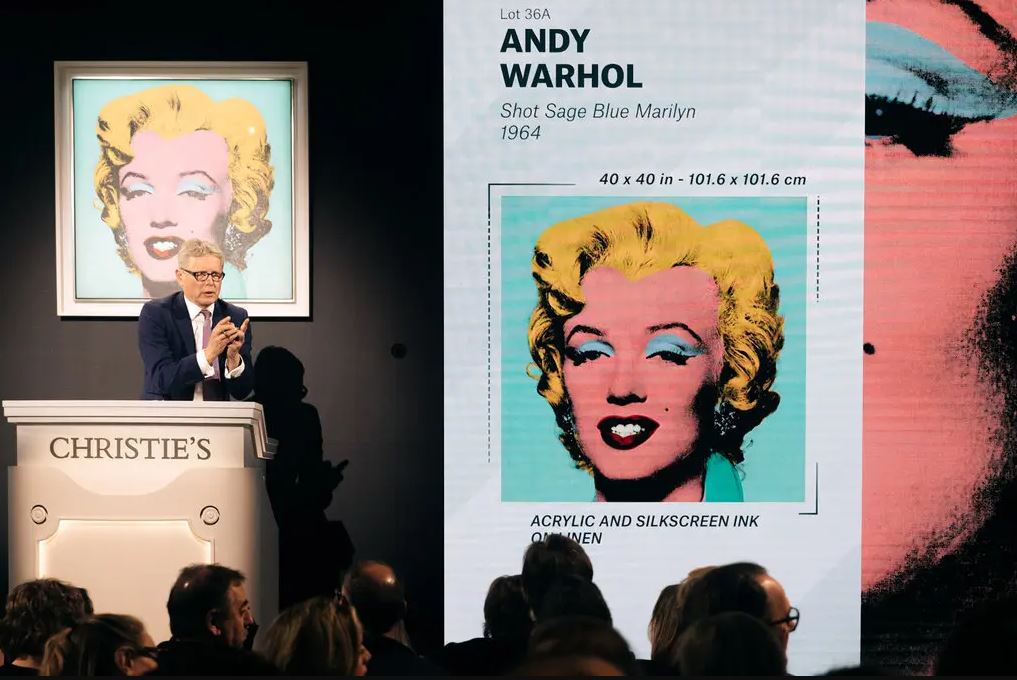Perhaps the picture is not racy, such as the one of Marilyn Monroe with her dress flying up in the film “The Seven Year Itch,” yet it was the most expensive on Monday night.
A silk-screen of the actress’s face by Andy Warhol, “Shot Sage Blue Marilyn,” sold for around $195 million to an unnamed bidder at Christie’s in New York in less than four minutes of bidding, making it the highest price ever paid for an American piece of art at auction.
The painting, which measures 40 by 40 inches and is considered a trophy because of its vibrant colours and glamorous subject matter, outperformed the previous auction record of $110.5 million paid for a Basquiat skull painting at Sotheby’s in 2017 as well as Warhol’s previous auction record of $105.4 million paid for a car crash painting in 2013.
The auction on Monday marked the beginning of the spring auction season in a city that has only just started to return to normal following two years of devastation caused by the coronavirus outbreak. Christie’s salesroom at Rockefeller Center was packed with familiar faces of dealers and art advisors who were visibly excited at the prospect of bidding on high-profile artworks in person for the first time in years.
In an interview with the New York Times, Philip Hoffman, founder of the Fine Art Group, said that the forthcoming two weeks of auctions may generate as much as $2 billion in revenue. According to him, “there has been a significant amount of money kept back over the last two years, and there is a significant amount of pent-up demand from new customers.” ‘Everyone has been waiting for the perfect time, and the right moment has now arrived.’
The Christie’s sale was notable in that none of the works were accompanied by a guarantee, which is a minimum price at which a third party or the auction house has promised to purchasing the piece at the auction’s conclusion. The reason for this is because the pieces were donated by the estate of Swiss art dealers Thomas and Doris Ammann, with all of the revenues going to their foundation, which provides health care and educational opportunities for children. The estate wanted to maximise the amount of money donated to charity.
The buyer of the “Marilyn” painting will have a vote in determining which charity will get a portion of the artwork’s revenues (twenty percent of the sale price). According to Christie’s, since the purchase is not deemed a charity contribution, it does not qualify for a tax benefit.
In 1977, the Ammann siblings opened a gallery in Zurich that specialised in Impressionist, Modern, postwar, and contemporary painters, as well as modern and contemporary art. After Thomas Ammann’s death in 1993, his sister continued to serve as director of the museum until her death in 2008. She passed away the previous year.
Two lots did not sell, but the 36 works in the sale brought a total of $318 million (two lots did not sell). The sale proved once again that high-quality works sell for high prices, no matter how tumultuous the state of the world is — whether it is a war in another country, a pandemic, or a terrorist attack.
The auction, which took place in Christie’s newly constructed sales room, which included experts on each side of the room and reporters perched on stools in the rear, started strong. As the renowned auctioneer Jussi Pylkkanen alternated between bidding on the phone and bidders in the seats, the room hummed with excitement. “I’ve had 15 bids for this one!” he exclaimed as Ann Craven’s three-bird painting, “I Wasn’t Sorry, 2003,” went for $680,400, well above the top estimate of $40,000.
Given their history as rivals as well as collaborators and personal friends, the connection between Warhol and Basquiat continues to captivate people. When the two artists collaborated on a series of paintings in 1985, the dealer Tony Shafrazi developed a billboard to promote his exhibition of the works, which portrayed them in boxing gloves, as if they were about to fight with each other.
“I really love that they’re still engaged in this boxing battle with one another, even after they’ve died,” said Jessica Beck, curator of art at the Andy Warhol Museum in Pittsburgh. “It’s a beautiful thing.” “They’re still fighting in the market, and there’s still such a frenzy of attention focused on their work — and their work continues to be so modern.” “Their work is still contemporary.”
Asked on his way into the auction whether he would consider selling his version of the “Marilyn” series, Brant said that it had emotional importance to him and that he would not contemplate doing so. “No,” Brant said emphatically. “Unquestionably not.”

